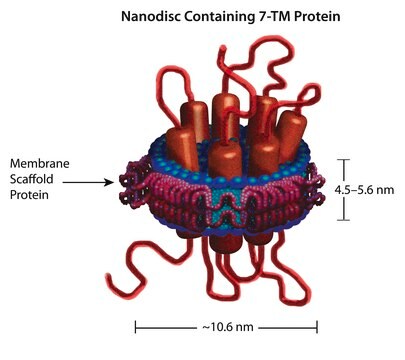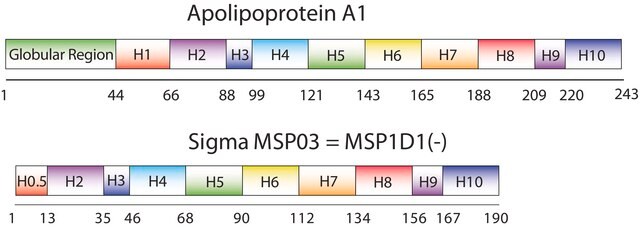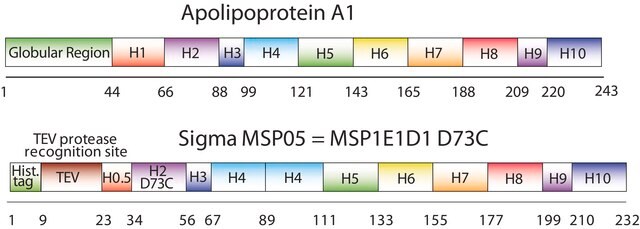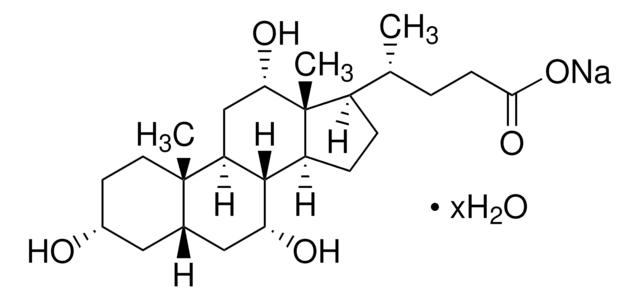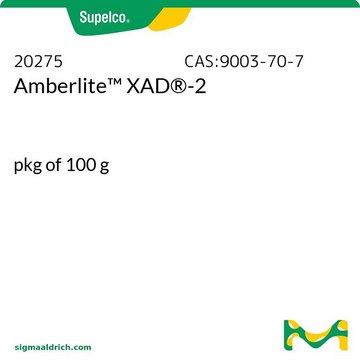MSP01
Membrane Scaffold Protein 1D1
recombinant, expressed in E. coli, buffered aqueous solution
Sinonimo/i:
Membrane Scaffold Protein 1D1, MSP1D1, MSP1T2
Autenticatiper visualizzare i prezzi riservati alla tua organizzazione & contrattuali
About This Item
Codice UNSPSC:
12352200
NACRES:
NA.26
Prodotti consigliati
Ricombinante
expressed in E. coli
Livello qualitativo
Saggio
≥90% (SDS-GE)
Stato
buffered aqueous solution
PM
24,661.6 Da
Solubilità
water: soluble
Condizioni di spedizione
dry ice
Temperatura di conservazione
−20°C
Cerchi prodotti simili? Visita Guida al confronto tra prodotti
Descrizione generale
Research area: Cell signaling. Nanodiscs are non-covalent structures that contain a phospholipidbilayer and a membrane scaffold protein (MSP), a genetically engineeredprotein, that mimics the function of Apolipoprotein A-1 (ApoA-1). The firstMSP, MSP1, was engineered with its sequence based on the sequence of A-1, butwithout the globular N-terminal domain of native A-1. The Membrane ScaffoldProtein 1D1 (MSP1D1) variant of MSP1 deletes the first 11 amino acids in theHelix 1 portion (referred to as “H0.5” in the accompanying figure) of theoriginal MSP1 sequence.It consists of an N-terminal histidine-tagged protein with a tobaccoetch virus (TEV) protease cleavage site that is present between the proteinsequence and histidine-tag.Nano-disctechnology is an approach that allows aqueous soluble membrane proteins in anative-like bilayer environment that enables the membrane proteins to remainactive and stable.
Applicazioni
For an extensive list of citations and protocols visit the Sligar Lab Website at; sligarlab.life.uiuc.edu/nanodisc.html
For guidelines on the use of this and other MSP′s to prepare Nanodiscs, please visit our Protocols for Membrane Scaffold Proteins and Nanodisc Formation page.
Nanodisc soluble lipid bilayer systems have proven to be a widely applicable means for rendering membrane proteins soluble in aqueous solutions in a native-like bilayer environment where they remain monodisperse and active. The critical component of nanodiscs is the encircling amphipathic helical protein belt (membrane scaffold protein).
The nanodisc system has been employed to incorporate a wide variety of proteins including GPCRs, P450s, bacteriorhodopsin, coagulation factors, cholera toxin, TAR receptor and aromatase.
Azioni biochim/fisiol
Generates Nanodiscs ~9.7 nm in diameter
MSP1D1 can self-assembleinto discoidal nanoparticles known as nano-discs. These nano-discs may be used inthe field of medicine, biotechnology, and membrane protein studies.
Note legali
Nanodisc technology, and many of its uses, are covered by the following patents held by the University of Illinois.
- 7,691,414 Membrane scaffold proteins
- 7,662,410 Membrane scaffold proteins and embedded membrane proteins
- 7,622,437 Tissue factor compositions and methods
- 7,592,008 Membrane scaffold proteins
- 7,575,763 Membrane scaffold proteins and tethered membrane proteins
- 7,083,958 Membrane scaffold proteins
- 7,048,949 Membrane scaffold proteins
Nanodisc technology, and many of its uses, are covered by the following patents held by the University of Illinois.
- 7,691,414 Membrane scaffold proteins
- 7,662,410 Membrane scaffold proteins and embedded membrane proteins
- 7,622,437 Tissue factor compositions and methods
- 7,592,008 Membrane scaffold proteins
- 7,575,763 Membrane scaffold proteins and tethered membrane proteins
- 7,083,958 Membrane scaffold proteins
- 7,048,949 Membrane scaffold proteins
Codice della classe di stoccaggio
10 - Combustible liquids
Classe di pericolosità dell'acqua (WGK)
WGK 2
Punto d’infiammabilità (°F)
Not applicable
Punto d’infiammabilità (°C)
Not applicable
Scegli una delle versioni più recenti:
Possiedi già questo prodotto?
I documenti relativi ai prodotti acquistati recentemente sono disponibili nell’Archivio dei documenti.
I clienti hanno visto anche
Christopher I Cazzonelli et al.
eLife, 9 (2020-02-01)
Carotenoids are a core plastid component and yet their regulatory function during plastid biogenesis remains enigmatic. A unique carotenoid biosynthesis mutant, carotenoid chloroplast regulation 2 (ccr2), that has no prolamellar body (PLB) and normal PROTOCHLOROPHYLLIDE OXIDOREDUCTASE (POR) levels, was used
Benjamin J Cole et al.
PLoS biology, 15(9), e2002860-e2002860 (2017-09-25)
Diverse soil-resident bacteria can contribute to plant growth and health, but the molecular mechanisms enabling them to effectively colonize their plant hosts remain poorly understood. We used randomly barcoded transposon mutagenesis sequencing (RB-TnSeq) in Pseudomonas simiae, a model root-colonizing bacterium
Yan Bao et al.
Autophagy, 14(9), 1562-1573 (2018-06-27)
Macroautophagy/autophagy is a conserved process in eukaryotes that contributes to cell survival in response to stress. Previously, we found that endoplasmic reticulum (ER) stress induces autophagy in plants via a pathway dependent upon AT5G24360/IRE1B (INOSITOL REQUIRING 1-1), an ER membrane-anchored
Ping Wang et al.
Autophagy, 16(1), 123-139 (2019-03-27)
Autophagy is a conserved catabolic process in eukaryotes that contributes to cell survival in response to multiple stresses and is important for organism fitness. In Arabidopsis thaliana, the core machinery of autophagy is well defined, but its transcriptional regulation is
Protocolli
Protocols for Membrane Scaffold Proteins and Nanodisc Formation
Il team dei nostri ricercatori vanta grande esperienza in tutte le aree della ricerca quali Life Science, scienza dei materiali, sintesi chimica, cromatografia, discipline analitiche, ecc..
Contatta l'Assistenza Tecnica.

